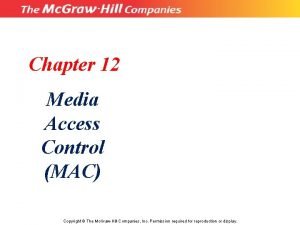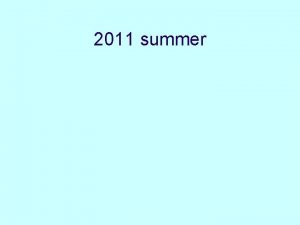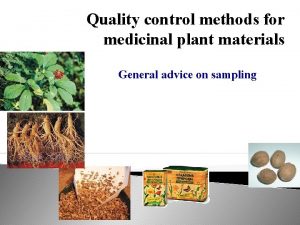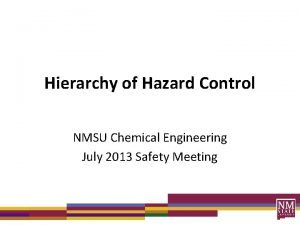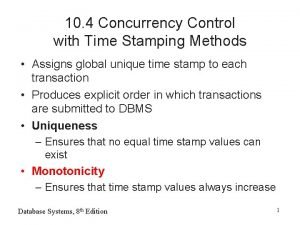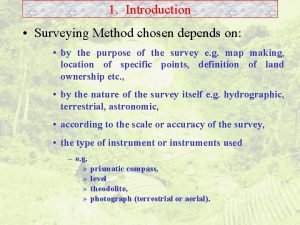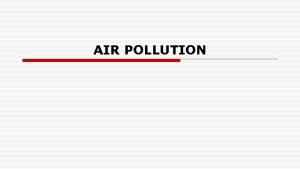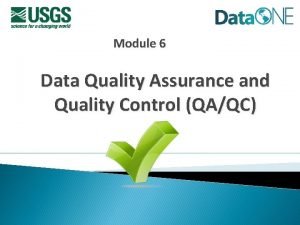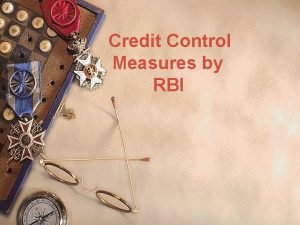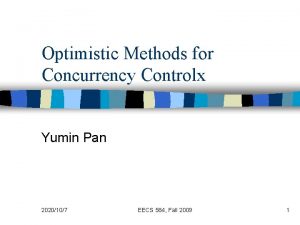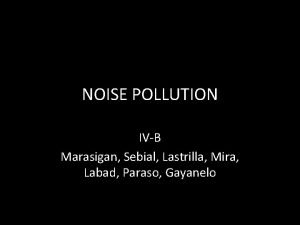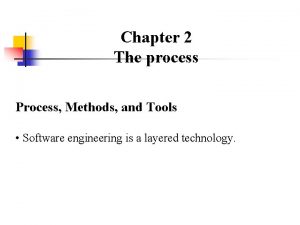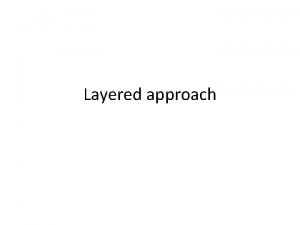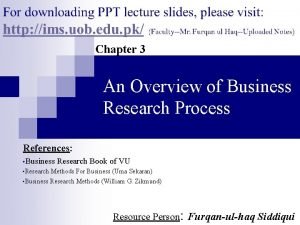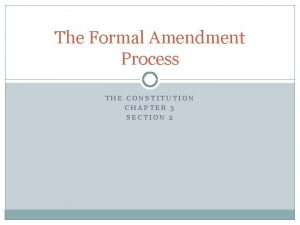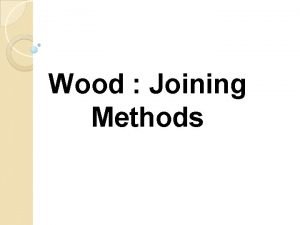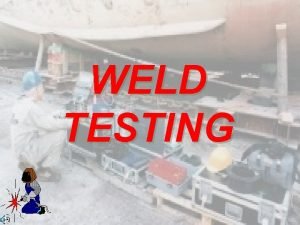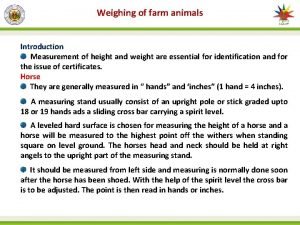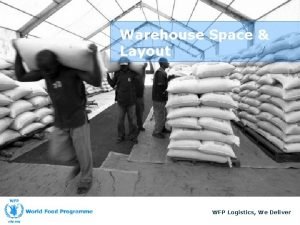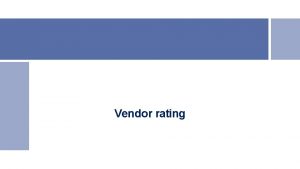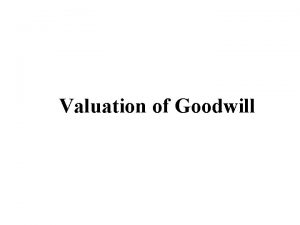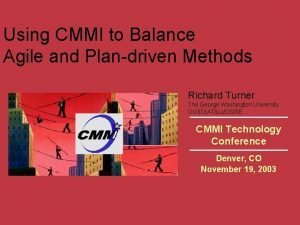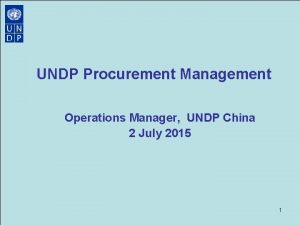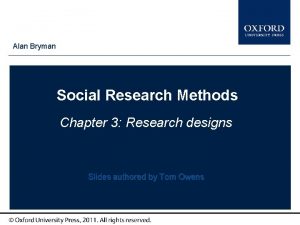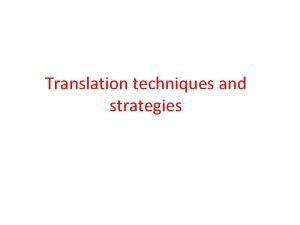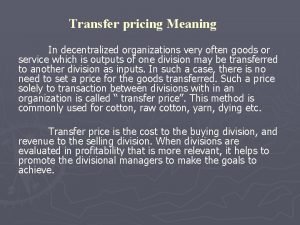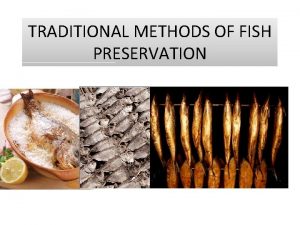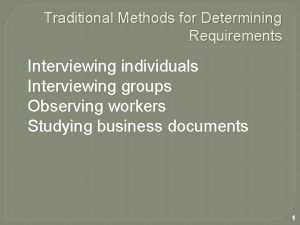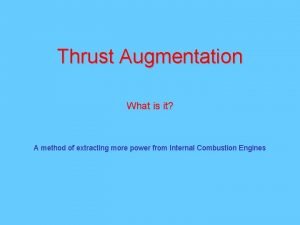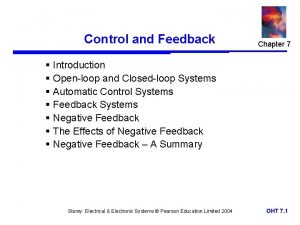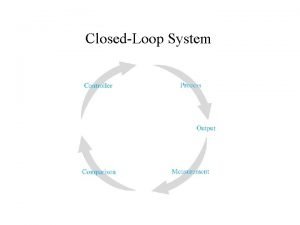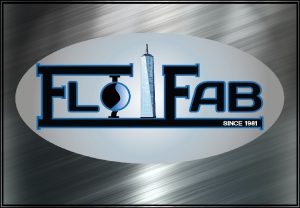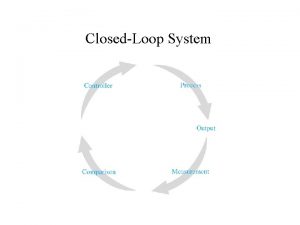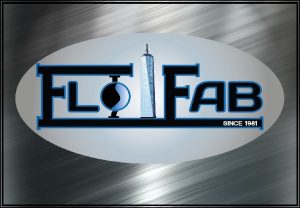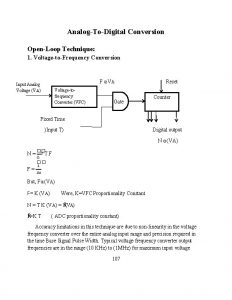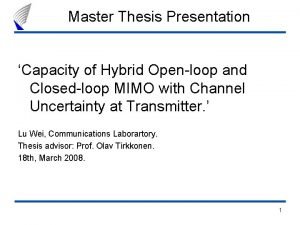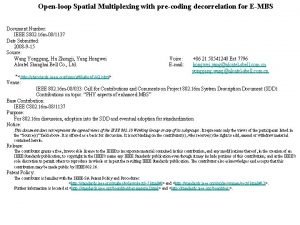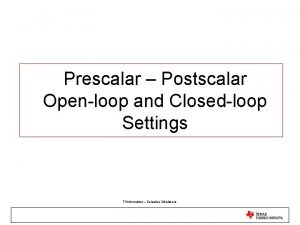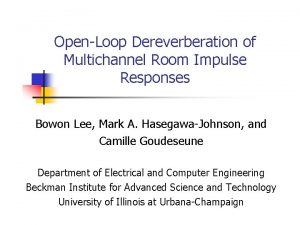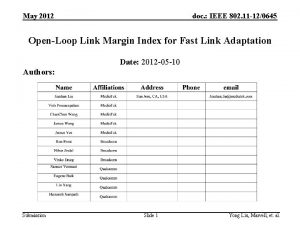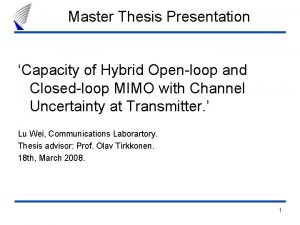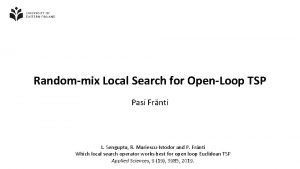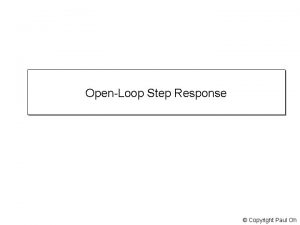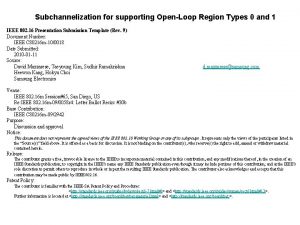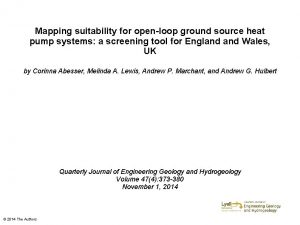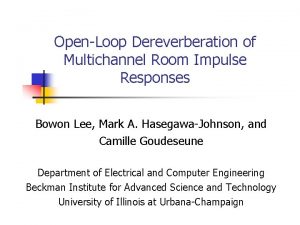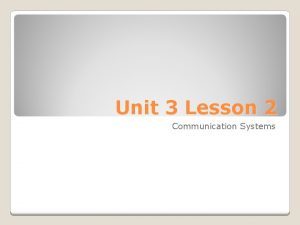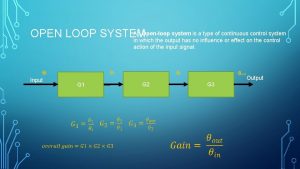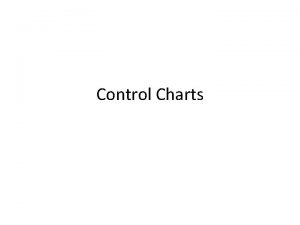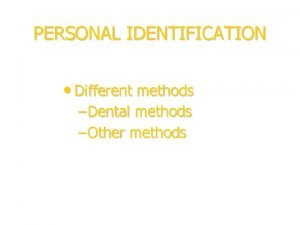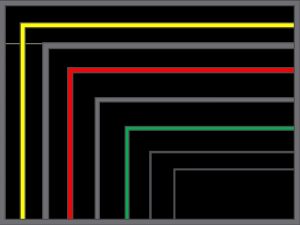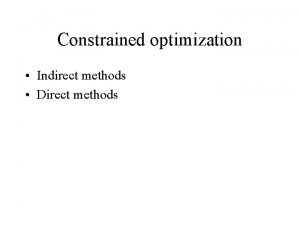Process Control Methods 1 OpenLoop Control Process control






































- Slides: 38

Process Control Methods 1

Open-Loop Control • Process control operations are performed automatically by either open-loop or closed-loop systems • Processes controlled only by set-point commands without feedback are open-loop • Open-loop systems are used in applications where simple processes are performed • Open-loop systems are relatively inexpensive 2

Closed-Loop Control • Closed-loop control systems are more effective than openloop systems • With the addition of a feedback loop they become self-regulating • Components of a closedloop system include: – The primary element sensor – The controlled variable – The measured variable – The control signal – The final correcting element 3

Process Behavior • The objective of process control is to cause a controlled variable to remain at a constant value at or near some desired set-point • The controlled variable changes because of: – A disturbance appears – Load demands vary – Set points are adjusted 4

Process Behavior Example • Flow through the pipe is the process • Fluid flow rate is the controlled variable • Valve position is the set point • Demand for the fluid downstream is the load • Variance in upstream pressure is the disturbance 5

Single-Variable Control Loop • Several process variables are controlled at once in a typical production machine • Usually, only one individual feedback loop is required to control each variable • Single-variable control loops consist of the following elements: – – Measuring device Transducer/transmitter Controller Final Control Element 6

Response Time of the Instrument • All instruments have a time lag - the time from when a variable is measured till the corrective action is taken • Factors affecting lag: – Response time of sensor – Time lag of transducer – Distance the signal must travel – Time required for the controller to process – Distance control signal must travel – Time lag of the final correcting element 7

Time Lag • The controlled variable itself may contribute to lag problems because of inertia in the variable • Lag due to inertia of the variable is referred to as pure lag • Another factor that affects time lag is dead time this is the elapsed time from when the deviation occurs and corrective action takes place 8

Illustration of Pure Lag 9

Selecting a Controller • The controller mode selection is based upon the requirements of the process and one of the following control modes will be used: – – On/Off Proportional Integral Derivative 10

On-Off Control • • Used for slow acting operations where lag is unavoidable Final correcting element is either fully-on or fully-off The primary drawback of on-off control is the rapid switching of the final control element On-off differential or hysteresis is programmed into the controller • Deadband refers to the differing levels at which a controller switches on and off 11

Continuous Control • On/Off control is acceptable for process where the variable is set between two limits • For processes where the variable needs to be kept at particular setpoint level, proportional control is used • Proportional action can be accomplished in two ways: – Time Proportioning Method – Amplitude Proportional Method 12

Time Proportioning • Is a method whereby the output of the controller is continually switched on and off • On versus off times are varied dependent upon process requirements 13

Amplitude Proportional • Most common technique to produce a proportional signal • The control signal is proportional in amplitude to the error signal • The signal may be amplified and the amplification may be referred to as proportional gain and proportional band 14

Proportional Gain Comparison Level control at a gain of 1 15

Proportional Gain Comparison (Gain set at 2) 16

Proportional Band • Proportional band is defined as the percentage change in the controlled variable that causes the final correcting element to go through 100 percent of its range Controlled Variable % Change PB = Final Correcting Element % Change 17

Integral Control • Because of the introduction of offset in a control process, proportional control alone is often used in conjunction with Integral control • Offset is the difference between set point and the measured value after corrective action has taken place 18

Reset Action • Integral control is also referred to as reset control as the set point is continuously reset as long as an error is present • Integral adjustments that affect the output are labeled 3 ways: – Gain - expressed as a whole number – Reset - Expressed in repeats per minute – Integral Time - Expressed in minutes per reset 19

Derivative Mode • • For rapid load changes, the derivative mode is typically used to prevent oscillation in a process system The derivative mode responds to the rate of change of the error signal rather than its amplitude Derivative mode is never used by itself, but in combination with other modes Derivative action cannot remove offset 20

Control Mode Summary 21

Tuning the Controller • Fine-tuning is the process to optimize the controller operation by adjusting the following settings: – Gain setting (proportional mode) – Reset rate (integral mode) – Rate (derivative mode) • Three steps are taken when tuning a systems – Study the control loop – Obtain clearance for tuning procedures – Confirm the correction operation of the system components 22

Trial-and-Error Tuning • Does not use mathematical methods, instead a chart recorder is used and several bump tests are made in the proportional and integral modes • Trial-and-error tuning is very time consuming and requires considerable experience on the part of the technician or operator 23

Ziegler-Nichols Tuning Methods • Two formal procedures for tuning control loops: – Continuous cycling method – Reaction curve method 24

Continuous Cycling Method • The continuous cycling method analyzes the process by forcing the controlled variable to oscillate in even, continuous cycles • The time duration of one cycle is called an ultimate period. The proportional setting that causes the cycling is called the ultimate proportional value • These two values are then used in mathematical formulas to calculate the controller settings 25

Continuous Cycle Calculations • Proportional only controller • Proportional Gain – Kc = Gu x 0. 5 • KC = proportional gain, • Gu= ultimate gain • Proportional Band – PB = Pbu x 2 • PB = proportional band • Pbu = ultimate proportional band 26

Continuous Cycling Formulas 27

Ziegler-Nichols Reaction Curve Tuning Method • This method avoids the forced oscillations that are found in the continuous cycle tuning method • Cycling should be avoided if the process is hazardous or critical • This method uses step changes and the rate at which the process reacts is recorded • The graph produces three different values used in mathematical calculations to determine the proper controller settings 28

Reaction Curve Tuning Formulas 29

Direct Synthesis Method • • The direct synthesis method uses the same procedures to analyze the process times as the Ziegler-Nichols reaction curve method One advantage of this method is that it directly matches (synthesizes) synthesizes the process The first step in this method is perform a bump test and recording the dynamic settling time Depending upon the complexity of the process, one of several dynamic response signals may develop as shown on the right 30

Direct Synthesis Tuning Calculations 31

Advanced Control Techniques • Some complex manufacturing operations require more precise control than available with PID controllers • Four Techniques frequently used are: – – Cascade control Feed forward control Ratio control Adaptive control 32

Cascade Control • Cascade control systems use a second feedback loop with a separate sensor and controller • Cascade control is effective in overcoming lag in some systems 33

Feedforward Control • Feedforward control measures a variable that enters a process and takes corrective action if it is affected by a disturbance, reducing or eliminating deviation from the set point 34

Ratio Control • Used in mixing systems where an uncontrolled flow of material (wild flow) is monitored and used to control the second material which is controlled according to the desired ratio between the two components 35

Adaptive Control • To accommodate a nonlinear process, a microelectronic controller uses software that has adaptive control capabilities to compensate for nonlinear transducers and sensors 36

END 37

• This workforce solution was funded by a grant awarded by the U. S. Department of Labor’s Employment and Training Administration. The solution was created by the grantee and does not necessarily reflect the official position of the U. S. Department of Labor. The Department of Labor makes not guarantees, warranties, or assurances of any kind, express or implied, with respect to such information, including any information on linked sites and including, but not limited to, accuracy of the information or tis completeness, timeliness, usefulness, adequacy, continued availability, or ownership. This work by Mineral Area College is licensed under the Creative Commons Attribution 4. 0 International License.
 Wax pattern fabrication
Wax pattern fabrication Methods to control water pollution
Methods to control water pollution Media access control methods
Media access control methods Methods of portion control in bread and pastry
Methods of portion control in bread and pastry Nominal length in surveying
Nominal length in surveying Quality control methods for medicinal plant materials
Quality control methods for medicinal plant materials Nmsu chemical engineering
Nmsu chemical engineering Concurrency control with time stamping methods
Concurrency control with time stamping methods Methods of establishing control points in surveying
Methods of establishing control points in surveying Air pollution control methods
Air pollution control methods What is quality control definition
What is quality control definition Credit control measures by rbi
Credit control measures by rbi On optimistic methods for concurrency control
On optimistic methods for concurrency control Ways to prevent noise pollution in party at neighborhood
Ways to prevent noise pollution in party at neighborhood Process methods and tools in software engineering
Process methods and tools in software engineering Process methods and tools
Process methods and tools Business research chapter 3
Business research chapter 3 Formal amendment process definition
Formal amendment process definition Distinguish between process control and product control
Distinguish between process control and product control Signal phrases
Signal phrases Wood joining methods
Wood joining methods Destructive weld test
Destructive weld test Shaffer's formula
Shaffer's formula Warehouse capacity formula
Warehouse capacity formula Vertical jaw relation definition
Vertical jaw relation definition Vendor rating methods
Vendor rating methods U vegetable
U vegetable Disadvantages of god pod method
Disadvantages of god pod method Goodwill valuation methods
Goodwill valuation methods Innovative teaching methods in english
Innovative teaching methods in english Using risk to balance agile and plan driven methods
Using risk to balance agile and plan driven methods Procurement plan
Procurement plan Alan bryman
Alan bryman Translation loss definition
Translation loss definition Transfer price
Transfer price Traditional methods of fish preservation
Traditional methods of fish preservation How can ngt be used for requirements determination?
How can ngt be used for requirements determination? Methods of thrust augmentation
Methods of thrust augmentation Combination method of cooking
Combination method of cooking


